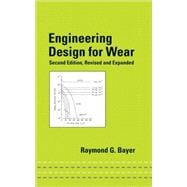
Note: Supplemental materials are not guaranteed with Rental or Used book purchases.
Purchase Benefits
Looking to rent a book? Rent Engineering Design for Wear, Second Edition, Revised and Expanded [ISBN: 9780824747725] for the semester, quarter, and short term or search our site for other textbooks by Bayer; Raymond G.. Renting a textbook can save you up to 90% from the cost of buying.
| Preface | v | ||||
|
1 | (44) | |||
|
1 | (1) | |||
|
2 | (1) | |||
|
3 | (2) | |||
|
5 | (1) | |||
|
5 | (1) | |||
|
6 | (11) | |||
|
17 | (1) | |||
|
17 | (28) | |||
|
45 | (92) | |||
|
45 | (4) | |||
|
49 | (6) | |||
|
55 | (1) | |||
|
56 | (19) | |||
|
75 | (14) | |||
|
89 | (7) | |||
|
96 | (8) | |||
|
104 | (19) | |||
|
123 | (4) | |||
|
127 | (10) | |||
|
137 | (14) | |||
|
137 | (3) | |||
|
140 | (2) | |||
|
142 | (5) | |||
|
147 | (1) | |||
|
147 | (1) | |||
|
148 | (3) | |||
|
151 | (10) | |||
|
151 | (1) | |||
|
151 | (10) | |||
|
151 | (1) | |||
|
151 | (1) | |||
|
152 | (1) | |||
|
152 | (1) | |||
|
152 | (1) | |||
|
153 | (1) | |||
|
153 | (1) | |||
|
153 | (1) | |||
|
154 | (1) | |||
|
154 | (1) | |||
|
154 | (1) | |||
|
155 | (1) | |||
|
155 | (1) | |||
|
155 | (1) | |||
|
155 | (1) | |||
|
155 | (1) | |||
|
156 | (1) | |||
|
156 | (1) | |||
|
156 | (1) | |||
|
156 | (1) | |||
|
156 | (1) | |||
|
157 | (1) | |||
|
157 | (1) | |||
|
157 | (1) | |||
|
157 | (1) | |||
|
158 | (1) | |||
|
158 | (1) | |||
|
158 | (1) | |||
|
158 | (1) | |||
|
159 | (1) | |||
|
159 | (1) | |||
|
159 | (1) | |||
|
159 | (1) | |||
|
160 | (1) | |||
|
161 | (164) | |||
|
161 | (1) | |||
|
161 | (8) | |||
|
169 | (4) | |||
|
173 | (4) | |||
|
177 | (2) | |||
|
179 | (8) | |||
|
187 | (15) | |||
|
202 | (14) | |||
|
216 | (14) | |||
|
230 | (7) | |||
|
237 | (18) | |||
|
255 | (14) | |||
|
269 | (14) | |||
|
283 | (9) | |||
|
292 | (8) | |||
|
300 | (4) | |||
|
304 | (3) | |||
|
307 | (6) | |||
|
313 | (12) | |||
|
325 | (4) | |||
|
325 | (1) | |||
|
326 | (1) | |||
|
327 | (1) | |||
|
328 | (1) | |||
|
329 | (38) | |||
|
329 | (1) | |||
|
329 | (7) | |||
|
336 | (3) | |||
|
339 | (6) | |||
|
345 | (4) | |||
|
349 | (4) | |||
|
353 | (1) | |||
|
354 | (1) | |||
|
355 | (3) | |||
|
358 | (9) | |||
| Glossary of Wear Mechanisms, Related Terms, and Phenomena | 367 | (8) | |||
| Appendix I: Values of m and n for Use with the Hertz Contact Stress Equations | 375 | (1) | |||
| Appendix II: Zero Wear Factors and Coefficients of Friction for Sliding | 376 | (8) | |||
| Appendix III: Wear and Friction Data | 384 | (11) | |||
| Appendix IV: Approximate Relationship Between Vickers Hardness and Yield Point in Shear | 395 | (1) | |||
| Appendix V: Galling Thershold Stress | 396 | (7) | |||
| Appendix VI: Wear Relationships for Sliding Wear Based on the Zero and Measurable Wear Models for Sliding | 403 | (7) | |||
| Appendix VII: Model for the Effect of Fluid Lubrication on Zero Wear Factors | 410 | (7) | |||
| Index | 417 |
The New copy of this book will include any supplemental materials advertised. Please check the title of the book to determine if it should include any access cards, study guides, lab manuals, CDs, etc.
The Used, Rental and eBook copies of this book are not guaranteed to include any supplemental materials. Typically, only the book itself is included. This is true even if the title states it includes any access cards, study guides, lab manuals, CDs, etc.